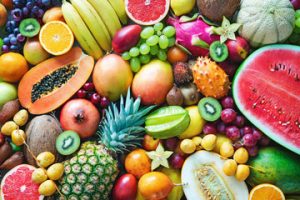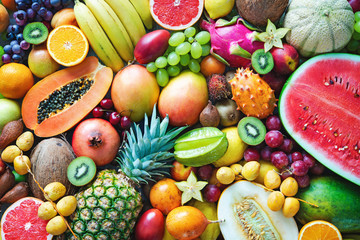The more colorful the food one eats, the healthier. Because the substances that color fruits and vegetables strengthen and protect our body very well.
Sure, fruits and vegetables are healthy. If only we would eat enough of it. According to a trend report published by the Nutrition Society in 2017, consumption of vegetables, berries and peel fruits increased, while consumption of fresh fruit and citrus fruit overall, showed a downward trend, while meat consumption, which was already too high, remained stable. Everyone should change their habits here, recommends nutritionist Silke Restemeyer. The goal is to eat five servings of fruit and vegetables daily, including 400 grams of vegetables and 250 grams of fruit.
Because both provide us not only vital vitamins but also phytochemicals. These are defense substances with which plants defend themselves against predators or microbial attacks. They also protect the human body, for example against free radicals and dangerous diseases. Some of the substances, which incidentally are responsible for the bright colors of carrots, grapes or tomatoes. The trick: The entire color palette can also be understood as a kind of map through the vital substance jungle.
Basically, The more varied and colorful you feed, the more important nutrients you absorb, says expert Restemeyer.
The Health Benefits of Each Food Based on their Colors

1. Red shields the sun’s rays
Lycopene is the name of the dye that gives red watermelons, currants, grapefruit and, above all, tomatoes. By the way, tomato paste contains more of it than fresh produce. Lycopene reduces the risk of cardiovascular disease and naturally prevents prostate cancer. It also protects us from harmful sun rays. A tablespoon of tomato paste daily can build about a sunscreen that corresponds to SPF 4. Red foods such as beetroot are rich in iron, which benefits pregnant women. But as they also get the blood and heart going, hotheads and people with a tendency to nervous anxiety should take a back seat with chilies or red peppers.
2. White cleans from the inside
The bright foods help with skin problems, clarify and support thanks to their pungent cleansing processes in our body and thus strengthen the immune system. Noteworthy here are garlic, onions or horseradish. Above all, our lungs benefit from the cleansing effect of white foods, as the ancient Chinese already knew. And by the way, white food should also calm our emotions and make us more balanced. Many foods, including asparagus, are known for their dehydrating effects. They not only purify and tighten the tissue but also relieve the heart and circulation. Dutch researchers were able to discover something better People who consume fruits and vegetables from the white group most often can reduce their stroke risk by half.
3. Yellow for a strong center
Here are carotenoids in the game that protect us from the damaging influence of free radicals. The dye is also regarded as a radical scavenger, which is represented in high concentrations, for example in apricots or apples. In the human body, it does, even more, inhibits inflammation or prevents thrombosis and allergies – a real all-rounder. No wonder that there is the famous saying An apple a day keeps the doctor away. Translated, it means that an apple spares the doctor every day. But beware: When peeling you lose a lot of the valuable ingredients, as it is in or directly under the shell. Also, yellow foods not only strengthen our nerves, but also provide abundant vitamin E, which acts as a support for connective tissue and cell protection and keeps skin and blood vessels elastic. In traditional Chinese medicine, yellows, such as pineapples, apricots or peppers are valued above all for their positive effects on the stomach and spleen, which are indispensable as the digestive organs for a strong center.
4. Green is good for the blood
It is considered to be the lifeblood of plants, but also for us humans the green pigment chlorophyll is enormously important. Because it is almost identical to our body’s own red blood pigment, hemoglobin, it acts as an excellent blood producer, providing pure and healthy blood. On top of that, it improves the oxygen supply in our body and helps detoxify it. Best suited: Green leafy vegetables such as spinach, chard or kale. Green foods help eliminate pollutants, such as pesticides, that we inevitably ingest with food. They cleanse from the inside and act on the intestinal tract like a natural antiseptic. Also, wherever chlorophyll is involved, there is always a lot of magnesium: gooseberries, peas, beans, kiwis provide the fuel that our hair, skin, nails and above all our muscles need.
5. Orange protects against cancer
Even with orange tones carotenoid mix vigorously. Studies show that people who consume a lot of carotenoid-rich fruit and vegetables, less likely to suffer a heart attack or cancer, says Silke Restemeyer. Probably the most well-known and best-researched representative of this group of substances is beta-carotene, which by the way the carrot owes its name. But also pumpkins, mangoes, and oranges are brimming with this vital substance. The special feature: It can be easily converted into vitamin A by the body. In this form, it reduces oxidation processes, regulates cell growth and is essential to our vision.
6. Purple is good for the heart and skin
The content in the purple, reddish or blue plants shows that they are true anti-aging miracle weapons. They help prevent wrinkles by preserving the skin’s collagen structure and keep the blood vessels young. Because: In the arteries, they prevent dangerous deposits, which in the long run can lead to trigger thrombosis, strokes and heart attacks. All good reasons, therefore, dark berry fruit, but also vegetables such as eggplant, red cabbage or red onions quiet more often on the menu. Research has also shown that women can reduce their risk of heart attack by more than 30 percent if they consume more than three servings of blueberries or strawberries per week. As a rule of thumb for optimal nutrition, the darker the fruit, the better.








